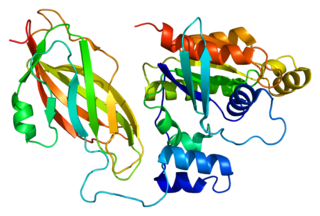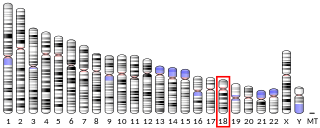
Melanotransferrin is a protein that in humans is encoded by the MFI2 gene. MFI2 has also recently been designated CD228.

G-protein coupled receptor 4 is a protein that in humans is encoded by the GPR4 gene.

Probable G-protein coupled receptor 110 is a protein that in humans is encoded by the GPR110 gene. This gene encodes a member of the adhesion-GPCR receptor family. Family members are characterized by an extended extracellular region with a variable number of N-terminal protein modules coupled to a TM7 region via a domain known as the GPCR-Autoproteolysis INducing (GAIN) domain.

5'-AMP-activated protein kinase catalytic subunit alpha-2 is an enzyme that in humans is encoded by the PRKAA2 gene.

Rac2 is a small signaling G protein, and is a member of the Rac subfamily of the family Rho family of GTPases. It is encoded by the gene RAC2.

Chloride intracellular channel protein 1 is a protein that in humans is encoded by the CLIC1 gene.

Formin-binding protein 1 is a protein that in humans is encoded by the FNBP1 gene.

Urea transporter 1 is a protein that in humans is encoded by the SLC14A1 gene.

Potassium-transporting ATPase alpha chain 2 is a protein that in humans is encoded by the ATP12A gene.

ATP-binding cassette sub-family A member 3 is a protein that in humans is encoded by the ABCA3 gene.

Sodium- and chloride-dependent glycine transporter 2, also known as glycine transporter 2 (GlyT2), is a protein that in humans is encoded by the SLC6A5 gene.

Zinc transporter ZIP1 is a protein that in humans is encoded by the SLC39A1 gene.

Angiopoietin-4 is a protein that in humans is encoded by the ANGPT4 gene.

Solute carrier organic anion transporter family member 1A2 is a protein that in humans is encoded by the SLCO1A2 gene.

S100 calcium-binding protein G (S100G) is a protein that in humans is encoded by the S100G gene.

Napsin-A is an aspartic proteinase that is encoded in humans by the NAPSA gene. The name napsin comes from novel aspartic proteinase of the pepsin family.

TATA element modulatory factor is a protein that in humans is encoded by the TMF1 gene.

Urea transporter 2 is a protein that in humans is encoded by the SLC14A2 gene.

Caveolin-2 is a protein that in humans is encoded by the CAV2 gene.

Ryanodine receptor 3 is one of a class of ryanodine receptors and a protein that in humans is encoded by the RYR3 gene. The protein encoded by this gene is both a calcium channel and a receptor for the plant alkaloid ryanodine. RYR3 and RYR1 control the resting calcium ion concentration in skeletal muscle.























